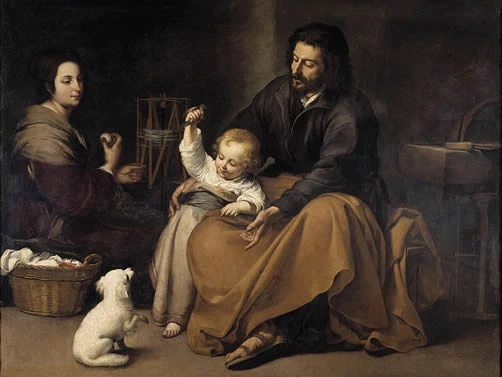The Works of Bartolomé Murillo
The works of Murillo undergo an evolution from the first subjects of his youth, depicting life in the poor neighborhoods of Seville with natural characteristics, to the Immaculate Conception paintings of his later years, revealing Baroque sensibility.
At first, his painting is influenced by the chiaroscuro of Zurbarán, who dominated all the commissions in Seville in the mid-17th century. However, fame quickly begins to smile down upon Murillo, who lightens his pallet and succeeds emphatically with the Sevillian ecclesiastical clientele, as the star of Zurbarán declines. Murillo's greatest concern is coloring, and he does not pay attention to the artistic investigation that is often assigned to Velázquez. Murillo's weakness is in complex composition and large formats. However, Murillo creates a personal style - tender, sweet, and delicate - that anticipates the Rococo period of the 18th century.
Murillo's landscapes include Dutch and Flemish influences. Evidence of this is his series of four preserved paintings of stories about Jacob that he painted for the Marquis of Villamanrique. Two of the works are currently located in the Hermitage Museum: Isaac Blessing Jacob and Jacob's Ladder. The remaining two are Laban Searching for his Stolen Household Gods, located in the Cleveland Museum of Art, and Jacob Laying Peeled Rods before the Flocks of Laban, in the Meadows Museum of Dallas.

Jacob Laying Peeled Rods before the Flocks of Laban, 1660, Meadows Museum, Dallas

Landscape, Prado Museum, Madrid
Murillo's religious paintings portray subjects in simple forms with images of everyday life.
A fundamental theme in Murillo's work has been the Immaculate Conception, with a pure, delicate, and harmonious appearance, seen in almost twenty paintings. For this reason, Murillo is known as the painter of the Immaculate Conception, surrounded by a grace that can seem excessively sentimental. The earliest is called Immaculate Conception (La Colosal), which, by its technique, can be placed at a date around 1650. The Immaculate Conception of Santa María la Blanca responds to the model created by the painter around 1660.

The Holy Family with a Little Bird, 1649-1650, Prado Museum, Madrid
Beginning in 1649, and due to the impact of the plague, Murillo receives no new commissions of magnitude. Consequently, he works on painting some of his most popular works, looking to express sacred themes naturally and with compassion. He paints several versions of the Virgin and Child. He also produces secular paintings during this time.
The Immaculate Conception of El Escorial also belongs to this period. The figure of the Virgin is billowy, with the cape barely attached to her body diagonally, a harmony of blue and white colors, a golden radiance surrounding the figure. All these features are repeated in later versions until the last, The Immaculate Conception of the Venerable Ones, which may have been commissioned in 1678 for one of the altars of the Hospital de los Venerables of Seville.

The Immaculate Conception of El Escorial, 1660-1665, Prado Museum, Madrid
Murillo also frequently addresses the theme of the Virgin and Child. These works are painted between 1650 and 1660 with the chiaroscuro technique, expressing feminine beauty and child-like grace.
Throughout his life, Murillo also produces a small number of portraits of notable variety, according to the needs of his clients. In some of these, the dignity of the character is highlighted. Others emphasize austerity of color or Flemish and Dutch influences by the format and allegorical contents.
Finally, Murillo leaves behind twenty-five genre paintings of realistic costumbrismo with principally child-like motifs. Almost all are commissioned by Flemish businessmen established in Seville. The protagonists are usually beggar children or humble families, but Murillo's figures always communicate optimism.

The Good Shepherd, 1660

Portrait of a Man, ca. 1660, Prado Museum, Madrid

Two Women at a Window, 1670, National Gallery, Washington

Alonso Miguel de Tovar